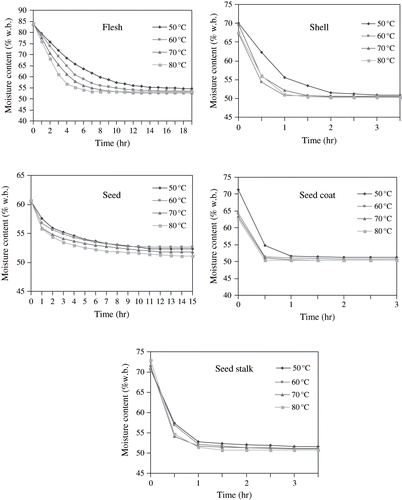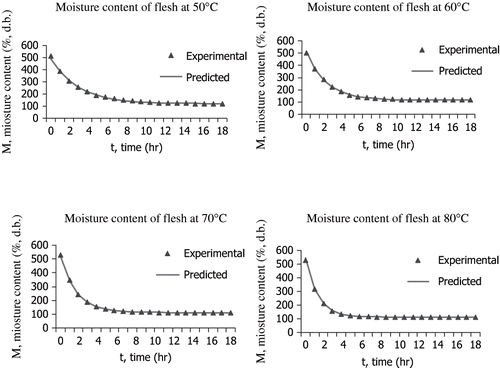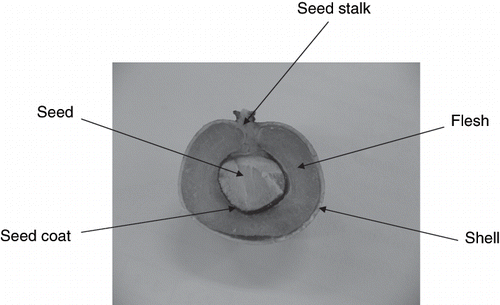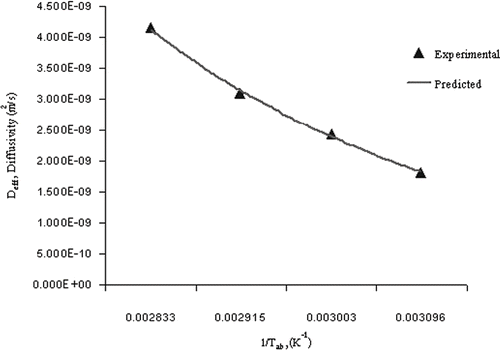Abstract
The components of the longan fruit were modeled as sphere for seed, cylinder for seed stalk, and slab for seed coat, shell, and flesh. The moisture diffusivities were determined by minimizing the sum of square of derivations between the predicted and experimental values of moisture content of thin layer drying under controlled conditions of air temperature and relative humidity. Experimental data were obtained from thin layer drying of the components in the form of sphere for seed, cylinder for seed stalk and slab for seed coat, shell and flesh. Air temperatures of 50, 60, 70, and 80°C and relative humidity in the range of 1.5–13.33% were used. The mean diffusivity of flesh of longan fruit increased with temperature, but the diffusivities of shell, seed coat, seed, and seed stalk were independent of temperature. The moisture diffusivities of shell and seed coat were much lower than those of the other parts of the longan.
INTRODUCTION
The mature Longan fruit (Dimocarpus Longan Lour.) is a small (Ca. 1.5–2 cm diameter) conical, heart shaped, or spherical in shape and light brown in color. It has a thin, leathery, and indehiscent pericarp surrounding a succulent, edible white aril. The aril contains a relatively dark brown seed. Maturity can be determined on the basis of fruit weight, skin color, flesh sugar concentration, flesh acid concentration, sugar to acid ratio, flavor, and/or days from anthesis. Longan fruits are non-climacteric with little change in soluble solid concentration (SSC) or titratable acidity (TA) after harvest. Longan fruits deteriorate rapidly unless proper handing and processing techniques are employed.[Citation1]
Longan fruit is grown commercially in many countries, including China, Thailand, India, and Vietnam. The crop is spread widely throughout the tropics, although China, Thailand, and Vietnam account for most of the fruit production. In China, Longan fruit is mostly marketed locally, and import of the fruit has been increasing recently; this trend is similar in Taiwan. Export of longan fruit from Thailand and Vietnam is increasing rapidly with Thailand currently the largest exporter followed by Vietnam.[Citation1]
Longan is an important commercial fruit in northern Thailand, and it is widely processed as dried fruits for exporting to China. Conventional hot air dryer are widely used for the production of dried longan. Energy consumption and product quality are the prime concerns of drying of longan. To understand the transport processes during drying is of importance for production of better quality of dried product and knowledge of the moisture diffusivity of longan is essential to understand the transport processes during drying.
Longan is a complex fruit consisting of shell, flesh, seed coat, seed, and seed stalk (). Because of their varying composition and microstructure, these components have different physical properties including moisture diffusivity. Moisture movement based on Fick's second law of diffusion can be used to interpret the phenomena of drying of longan fruit, and the moisture diffusivities of longan fruit components are needed to accurately predict the moisture transfer during drying.
Extensive research has been done on moisture diffusivity of single kernels and components of a kernel of different grains.[Citation2–10] Several studies have been reported on moisture diffusivity of fruits, vegetables, and spices.[Citation11–16] Panagiotou et al.[Citation17] reported moisture diffusivity of more than 100 food materials classified in 11 food categories and results concern the reported range of variation of moisture data together with the corresponding range of variation of material moisture content and temperature. Limited studies have been on overall effective diffusivity of longan fruit.[Citation18–21] But negligible study has been reported on the component diffusivities of the longan fruit. The purpose of our study is to determine the component diffusivities of the longan fruit.
MATERIALS AND METHODS
Longan fruit used in this investigation was collected from a fresh market of Chiang Mai, Thailand, and it was stored at 50°C in the Department of Food Engineering, Silpakron University, Nakhon Pathom. The initial moisture content of fresh longan was about 84% (w.b.). It was neither treated with chemicals or separated into components before conducting the experiment. Before starting an experiment the fruits were left in the room temperature in the laboratory in the Department of Physics, Silpakorn University, Nakhon Pathom, Thailand, and then single fruits were separated into shell, flesh, seed coat, seed, and seed stalk. Each of the components was dried separately in a laboratory dryer in the Physics Department, Silpakorn University, Nakhon Pathom, Thailand, under controlled conditions of temperature and relative humidity. The thin layer drying apparatus used is similar to that described by Guarte.[Citation22] The laboratory drying apparatus consists of a centrifugal blower, a drying section, an electrical resistance air heating section, measurement sensors, and data recording and controlling system with a personal computer. The thin layer drying tests were conducted in the temperature range of 50°C to 80°C, and the relative humidity of the drying air from 1.5 to 13.33%. Four sets of experiments were conducted for each of the components of the longan fruit.
Before starting an experiment, the drying apparatus was allowed to run for one hour to obtain steady temperature. Thin layer drying of the longan component was conducted at a temperature of 50, 60, 70, and 80°C. For each experiment, about 100 g of the components of the fresh longan fruit was spread in the drying chamber is a single layer. All the drying experiments were carried out at an air velocity of 0.2 m/s. The drying air temperatures were monitored using thermocouple (K type) connected to a personal computer using an interface at an interval of 5 min and the weights of longan components were recorded by an electronic balance (accuracy ± 0.01 g) at an interval of 1 h. Removing, weighing, and replacement required about 2 min.
Theoretical Consideration
Fick's second law of the unsteady state diffusion, neglecting the effects of temperature and total pressure gradient, can be used to describe the drying behavior of fruits.[Citation23]![]()
This equation can be solved for different standard shapes of the drying material. These equations are:
for sphere
for cylinder![]()
and for slab of half thickness, z![]()
EquationEquations (2) Equation to Equation(4) can be fitted to the experimental data of the products if the products have the shapes of sphere, cylinder, and slab, and the diffusivity can be determined minimizing sum of squares of the deviations between the predicted and experimental data.
The following assumptions are made in solving the EquationEqs (2) Equation to Equation(4): (1) drying is isothermal; (2) the fruit consists of five components: seed, seed stalk, flesh, seed coat, and shell. The seed is spherical and the seed stalk is cylindrical in shape, and the flesh, seed coat and shell are cut into the shape of slab; (3) each component of the fruit is homogenous; (4) initial moisture content is uniform; (5) moisture movement is one directional; (6) diffusivity is constant for each component of the fruit; and (7) shrinkage is negligible.
DETERMINATION OF DIFFUSIVITIES
Thin layer drying models of sphere for the seed, slab for flesh, seed coat and shell, and cylinder for the seed stalk were fitted to experimental data of thin layer drying of the components of the longan fruit. The suitability of the models was determined by using standard error of estimate and coefficient of determination. EquationEquation (2) was fitted to the experimental data of seed, EquationEq. (3) was fitted to the experimental data of seed stalk, and EquationEq. (4) was fitted to the experimental data of flesh, shell, and seed coat. Moisture diffusivity of each of the components of the longan fruit was determined by minimizing the sum of square of derivations between the experimental and predicted values for thin layer drying of the components under controlled conditions of air temperature and relative humidity.
RESULTS AND DISCUSSION
The influences of drying air temperature on drying curves for different components are shown in . The drying rate of the different components of longan increased with the increase of drying air temperature. The agreement between the predicted and observed results of moisture content of different components of longan fruit was found to be excellent. The comparison of the predicted values and experimental data of the moisture content for flesh of longan for different temperature are shown in and the agreement between the predicted and experimental value is excellent (R2 = 0.99).
Figure 2 Influences of the drying air temperatures on drying curves for different components of longan fruit.

Figure 3 Comparison of predicted values and experimental data of flesh of longan fruit for temperature of 50°C, 60°C, 70°C, and 80°C.

The diffusivities of the different components of the longan are shown in . The diffusivity of the flesh of longan is highly temperature dependent but for other components the diffusivity is independent of temperature. The diffusivity of the flesh can expressed as a function of temperature using Arrhenius type equation as:
Table 1 Diffusivities of different components of longan fruit
shows the variation of the moisture diffusivity of flesh of longan fruit as a function of the reciprocal of absolute drying air temperature. Achariyaviriya et al.[Citation18] reported the effective diffusivity of single longan fruit in the range of 1.389×10−11 to 3.750×10−10 m2/s. The mean value of the components of the longan fruit in this study lies in the range of 4.494×10−12 to 2.867×10−9 m2/s, and it is within the range of effective diffusivity of single longan fruit reported by Achariyaviriya et al.[Citation18] The mean value of the diffusivity of mango lies within the range of 8.846×10−11 to 1.935×10−10 m2/s, but the range is very narrow. This might be due to the difference in biological structure of longan and mango.
CONCLUSIONS
Moisture diffusivity of flesh of longan fruit increased with air temperature. But the air diffusivities of shell, seed coat, seed, and seed stalk were independent of temperature changes. Moisture diffusivities of shell and seed coat were much lower than those of the other components of longan fruit. Temperature dependence of the flesh of the longan fruit can be satisfactorily described by an Arrhenius-type equation. The mean value of the diffusivity of the components of the longan fruit in this study lies in the range of 4.494 × 10−12 to 2.867×10−9 m2/s.
NOMENCLATURE
| M | = |
Moisture content of components of longan fruit, % (d.b.) |
| Me | = |
Equilibrium moisture contents of the components of longan, % (d.b.) |
| Mo | = |
Initial moisture content of the components of longan, % (d.b.) |
| Deff | = |
Effective diffusivity, m2/s |
| Dflesh | = |
Diffusivity of flesh, m2/s |
| R | = |
Coefficient of determination, % |
| r | = |
Radius of the cylindrical seed stalk, m |
| ro | = |
Radius of seed, m |
| z | = |
Half thickness of the slab (shell, flesh, and seed coat), m |
| αn | = |
Roots of the Bessel function of zero order, n = 1,2,3… |
ACKNOWLEDGMENTS
This research is a part of the research project SFB 564 (“Research for Sustainable Land Use and Rural Development in Mountainous Regions of Southeast Asia”), funded by Deutsche Forchungsgemeinschaft (DFG), Germany, and co-funded by the National Research Council of Thailand and the Ministry of Science, Technology and Environment, Vietnam. We gratefully acknowledge the financial support for this research.
REFERENCES
- Jiang , Y. , Zhang , Z. , Joyce , D.C. and Kesta , S. 2002 . Postharvest Biology and Handling of Longan Fruit (Dimocarpus Longan Lour) . Postharvest Biology and Tech. , 26 : 241 – 252 .
- Kang , S. and Delwiche , S.R. 2000 . Moisture Diffusivity Coefficients of Single Wheat Kernels with Assumed Simplified Geometries, Analytical Approach . Transactions of the ASAE. , 42 ( 6 ) : 1653 – 1659 .
- Gaston , A.L. , Abalone , R.M. and Giner , S.A. 2002 . Wheat Drying Kinetics for Sphere and Ellipsoid by Finite Element . J.Food Eng. , 52 : 313 – 322 .
- Giner , S.A. and Mascheroni , R.H. 2002 . Diffusive Drying Kinetics in Wheat, Part II: Applying the Simplified Analytical Solution to Experimental Data . Biosystems Eng. , 81 ( 1 ) : 85 – 97 .
- Muthukumarappan , K. and Gunasekaran , S. 1994 . Moisture Diffusivity of Corn Kernel Components during Adsorption Part I: Germ . Trans. ASAE , 37 ( 4 ) : 1263 – 1268 .
- Muthukumarappan , K. and Gunasekaran , S. 1994 . Moisture Diffusivity of Corn Kernel during Adsoption Part II: Pericarp . Trans. ASAE , 37 ( 4 ) : 1269 – 1274 .
- Muthukumarappan , K. and Gunasekaran , S. 1994 . Moisture Diffusivity of Corn Kernal Components during Adsorption Part III: Soft and Hard Endosperms . Trans. ASAE , 37 ( 4 ) : 1275 – 1280 .
- Steffe , J.F. and Singh , R.P. 1980 . Diffusivity of Starchy Endosperm and Bran of Fresh and Rewetted Rice . J. food Sci. , 45 ( 2 ) : 356 – 361 .
- Steffe , J. F. and Singh , R.P. 1980 . Liquid Diffusivity of Rough Rice Components . Trans. ASAE , 23 ( 3 ) : 767 – 774 . 782
- Steffe , J.F. and Singh , R.P. 1980 . Diffusion Coefficients for Predicting Rice Drying Behaviour . J. Agric. Enging. Res. , 27 ( 6 ) : 489 – 493 .
- Azzouz , S. , Guizani , A. , Jomma , W. and Belghith . 2002 . Moisture Diffusivity and Drying Kinetic Equation of Convective Drying of Grapes . J. Food Eng. , 55 : 323 – 330 .
- Babalis , S.J. and Belessiotis , V.G. 2004 . Influence of the Drying Conditions on the Drying Constants and Moisture Diffusivity during Thin Layer Drying of Figs . J. Food Eng. , 65 : 449 – 458 .
- Sharma , G.P. and Prasad , S. 2004 . Effective Moisture Diffusivity of Garlic Cloves Undergoing Microwave-convective Drying . J. Food Eng. , 65 : 609 – 617 .
- Doymaz , I. 2005 . Drying Charateristics and Kinetics of Okra . J Food Eng. , 69 : 275 – 279 .
- Nguyen , T.A. , Verboven , P. , Scheerlinck , N. , Vandewalle , S. and Nicolai , B.M. 2006 . Estimation of Effective Diffusivity of Pear Tissue and Cuticle by Means of a Numerical Water Diffusivity Model . J. Food Eng. , 72 : 63 – 72 .
- Kaleemullah , S. and Kailappan , R. 2006 . Modeling of Thin Layer Drying Kinetics of Red Chilies . J. Food Eng. , 76 : 531 – 537 .
- Panagiotou , N.M. , Krokida , M.K. , Maroulis , Z.B. and Saravacos , G.D. 2004 . Moisture Diffusivity: Literature Data Compilation for Foodstuffs . International J Food Properties , 7 ( 2 ) : 273 – 299 .
- Achariyaviriya , A. and Punyabute , T. February 11 2003 . In Proceedings of the International Conference on Crop Harvesting and Processing , February 11 , Louisville, KY : Drying Kinetics of Longan Fruit without Stone .
- Achariyaviriya , A. , Soponronnarit , S. and Tiansuwan . 2001 . Study of Longan Flesh Drying . Drying Tec. , 9 ( 9 ) : 2315 – 2329 .
- Achariyaviriya , S. and Puttakarn , B. 2003 . A Mathematical Model of Moisture Diffusivity Lychee Drying . Proceedings of the International Conference on Crop Harvesting and Processing, ASABE Paper No. 701P1103e . February 11 2003 , Louisville, KY.
- Moreno-Castillo , E.J. , Gonzalez-Garcia , R. , Grajales-Lagunes , A. , Ruiz-Cabrera , M.A. and Abud-Archila , M. 2005 . Water Diffusivity and Color of Cactus Pear Fruits (Opuntia Ficus Indica) subjected to osmotic dehydration . International J Food Properties , 8 ( 2 ) : 323 – 336 .
- Guarte , R. 1996 . “ Modeling the drying behavior of copra and development of a natural convection dryer for production of high quality copra in the Philippines ” . In PhD Dissertation, Institute for Agricultural Engineering in the Tropics and Subtropics , Stuttgart, , Germany : The University of Hohenheim .
- Bala , B.K. 1997 . Drying and Storage of Cereal Grain , New Delhi, , India : Oxford & IBH Publishing Co .

